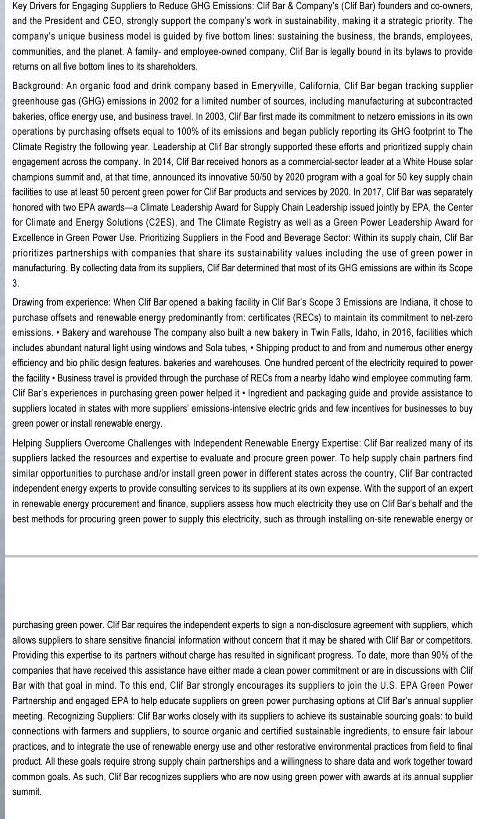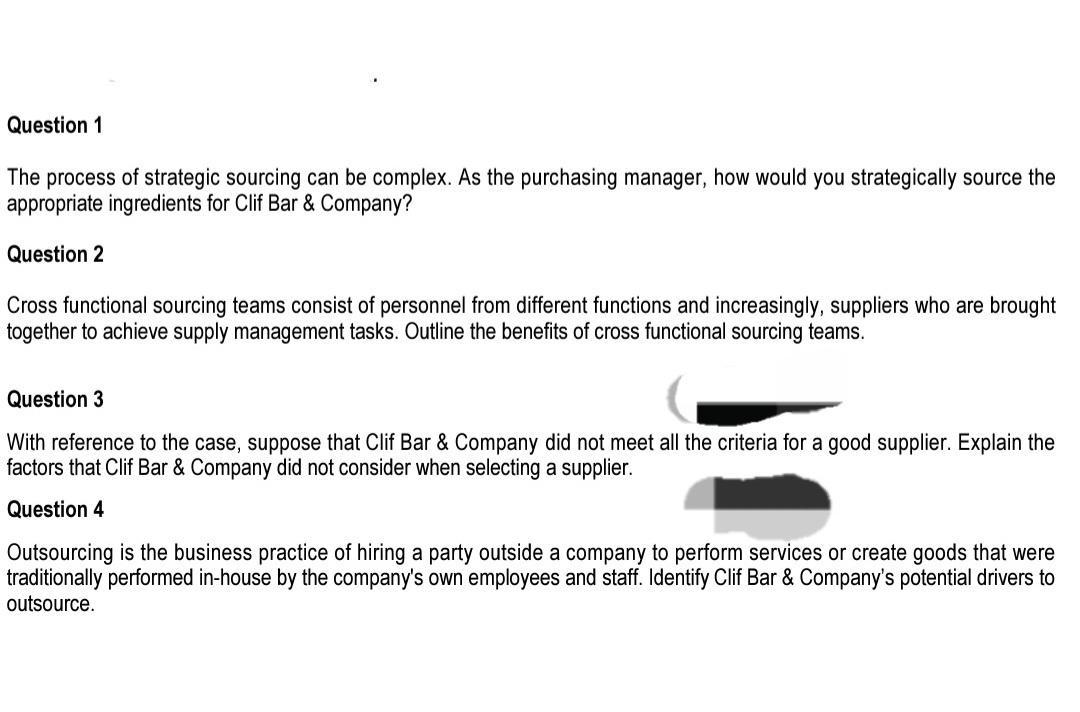Answered step by step
Verified Expert Solution
Question
1 Approved Answer
Key Drivers for Engaging Suppliers to Reduce GHG Emissions: Clif Bar & Company's (Clif Bar) founders and co-owners, and the President and CEO, strongly


Key Drivers for Engaging Suppliers to Reduce GHG Emissions: Clif Bar & Company's (Clif Bar) founders and co-owners, and the President and CEO, strongly support the company's work in sustainability, making it a strategic priority. The company's unique business model is guided by five bottom lines: sustaining the business, the brands, employees, communities, and the planet. A family- and employee-owned company, Clif Bar is legally bound in its bylaws to provide returns on all five bottom lines to its shareholders. Background: An organic food and drink company based in Emeryville, California, Clif Bar began tracking supplier greenhouse gas (GHG) emissions in 2002 for a limited number of sources, including manufacturing at subcontracted bakeries, office energy use, and business travel. In 2003, Clif Bar first made its commitment to netzero emissions in its own operations by purchasing offsets equal to 100% of its emissions and began publicly reporting its GHG footprint to The Climate Registry the following year. Leadership at Clif r strongly supported these efforts and prioritized supply chain engagement across the company. In 2014, Clif Bar received honors as a commercial-sector leader at a White House solar champions summit and, at that time, announced its innovative 50/50 by 2020 program with a goal for 50 key supply chain facilities to use at least 50 percent green power for Clif Bar products and services by 2020. In 2017, Clif Bar was separately honored with two EPA awards-a Climate Leadership Award for Supply Chain Leadership issued jointly by EPA, the Center for Climate and Energy Solutions (C2ES), and The Climate Registry as well as a Green Power Leadership Award for Excellence in Green Power Use. Prioritizing Suppliers in the Food and Beverage Sector: Within its supply chain, Clif Bar prioritizes partnerships with companies that share its sustainability values including the use of green power in manufacturing. By collecting data from its suppliers, Clif Bar determined that most of its GHG emissions are within its Scope 3. Drawing from experience: When Clif Bar opened a baking facility in Clif Bar's Scope 3 Emissions are Indiana, it chose to purchase offsets and renewable energy predominantly from: certificates (RECS) to maintain its commitment to net-zero emissions. Bakery and warehouse The company also built a new bakery in Twin Falls, Idaho, in 2016, facilities which includes abundant natural light using windows and Sala tubes, Shipping product to and from and numerous other energy efficiency and bio philic design features. bakeries and warehouses. One hundred percent of the electricity required to power the facility. Business travel is provided through the purchase of RECS from a nearby Idaho wind employee commuting farm, Clif Bar's experiences in purchasing green power helped it Ingredient and packaging guide and provide assistance to suppliers located in states with more suppliers' emissions-intensive electric grids and few incentives for businesses to buy green power or install renewable energy. Helping Suppliers Overcome Challenges with Independent Renewable Energy Expertise: Clif Bar realized many of its suppliers lacked the resources and expertise to evaluate and procure green power. To help supply chain partners find similar opportunities to purchase and/or install green power in different states across the country, Clif Bar contracted independent energy experts to provide consulting services to its suppliers at its own expense. With the support of an expert in renewable energy procurement and finance, suppliers assess how much electricity they use on Clif Bar's behalf and the best methods for procuring green power to supply this electricity, such as through installing on-site renewable energy or purchasing green power. Clif Bar requires the independent experts to sign a non-disclosure agreement with suppliers, which allows suppliers to share sensitive financial information without concern that it may be shared with Clif Bar or competitors. Providing this expertise to its partners without charge has resulted in significant progress. To date, more than 90% of the companies that have received this assistance have either made a clean power commitment or are in discussions with Clif Bar with that goal in mind. To this end, Clif Bar strongly encourages its suppliers to join the U.S. EPA Green Power Partnership and engaged EPA to help educate suppliers on green power purchasing options at Clif Bar's annual supplier meeting. Recognizing Suppliers: Clif Bar works closely with its suppliers to achieve its sustainable sourcing goals: to build connections with farmers and suppliers, to source organic and certified sustainable ingredients, to ensure fair labour practices, and to integrate the use of renewable energy use and other restorative environmental practices from field to final product. All these goals require strong supply chain partnerships and a willingness to share data and work together toward common goals. As such, Clif Bar recognizes suppliers who are now using green power with awards at its annual supplier summit. Question 1 The process of strategic sourcing can be complex. As the purchasing manager, how would you strategically source the appropriate ingredients for Clif Bar & Company? Question 2 Cross functional sourcing teams consist of personnel from different functions and increasingly, suppliers who are brought together to achieve supply management tasks. Outline the benefits of cross functional sourcing teams. Question 3 With reference to the case, suppose that Clif Bar & Company did not meet all the criteria for a good supplier. Explain the factors that Clif Bar & Company did not consider when selecting a supplier. Question 4 Outsourcing is the business practice of hiring a party outside a company to perform services or create goods that were traditionally performed in-house by the company's own employees and staff. Identify Clif Bar & Company's potential drivers to outsource.
Step by Step Solution
★★★★★
3.50 Rating (143 Votes )
There are 3 Steps involved in it
Step: 1
Question 1 As the purchasing manager strategically sourcing the appropriate ingredients for Clif Bar Company would involve several key steps 1 Supplier Evaluation Conduct a thorough evaluation of pote...
Get Instant Access to Expert-Tailored Solutions
See step-by-step solutions with expert insights and AI powered tools for academic success
Step: 2

Step: 3

Ace Your Homework with AI
Get the answers you need in no time with our AI-driven, step-by-step assistance
Get Started


